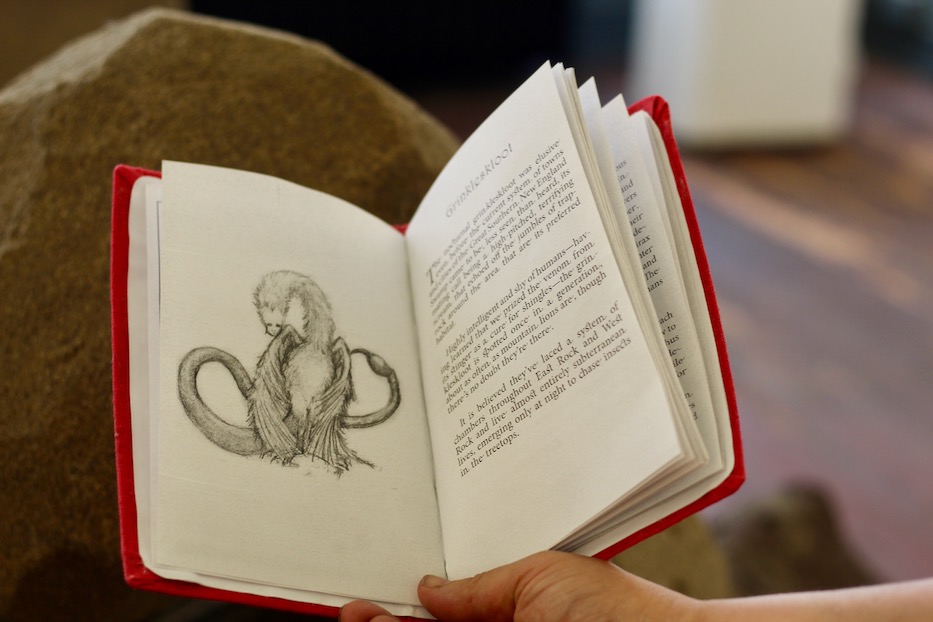
Downtown | Institute Library | Martha Lewis | Arts & Culture | Visual Arts
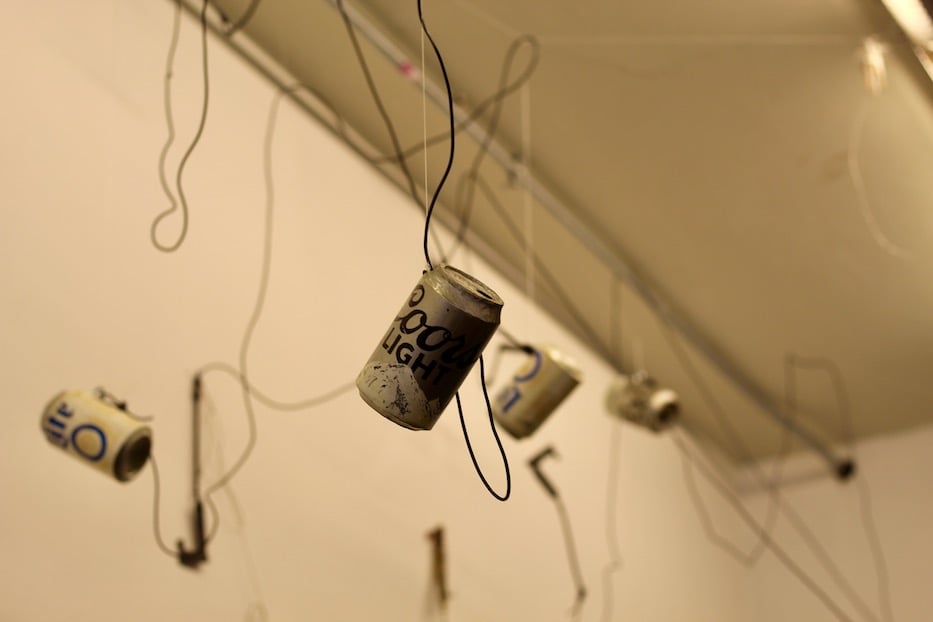
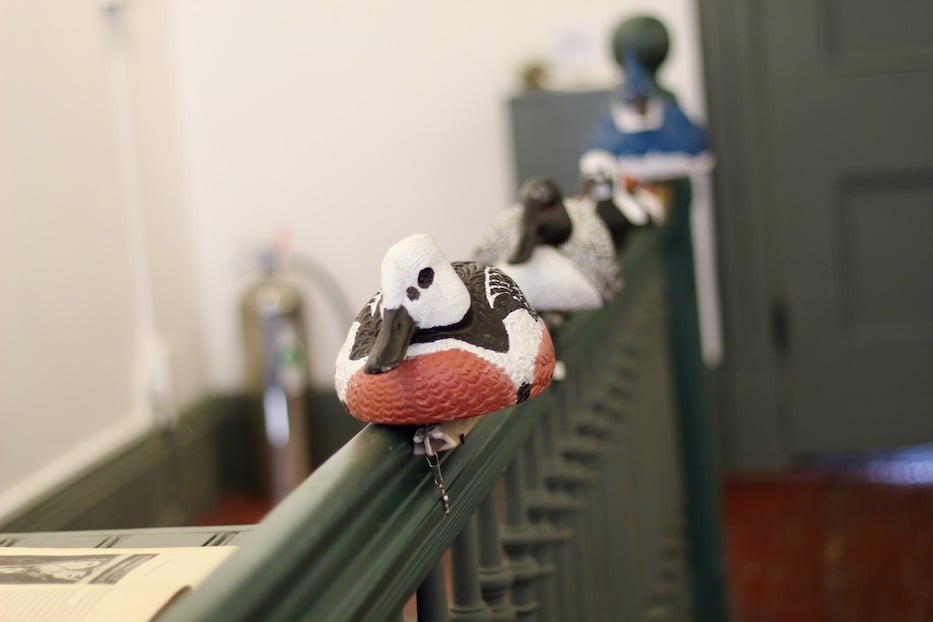 Work by the artist Scott Schuldt in Decoys & Mimics. The show, curated by artist Martha Lewis, runs at the Institute Library in downtown New Haven through Sept. 22. Lucy Gellman Photos.
Work by the artist Scott Schuldt in Decoys & Mimics. The show, curated by artist Martha Lewis, runs at the Institute Library in downtown New Haven through Sept. 22. Lucy Gellman Photos.
At first glance, it appears that beer cans have finally made it into the Institute Library’s collection, surrounded by a web of fishhook and snaking black wire. They bob and sway in space, their white and chrome exteriors catching in the light. A raft of ducks float on the banister below in a cacophony of color. Only when a viewer gets close enough do they realize that the pieces, painstakingly rendered in wood, are not at all what they seem.
Scott Schuldt’s freshwater fakeouts are part of Decoys & Mimics, running at the Institute Library at 847 Chapel St. through Sept. 22. The show, which opened in the IL’s upstairs gallery earlier this summer, explores the ideas of fact, substance, and sincerity through the eyes of 23 artists and a range of media, from the written word to sculpture. It is curated by artist Martha Lewis, whose interest in the library’s vast collection often reminds viewers that past and present are much closer than they sometimes seem.
In a years-long fight against disinformation, it feels right on time.
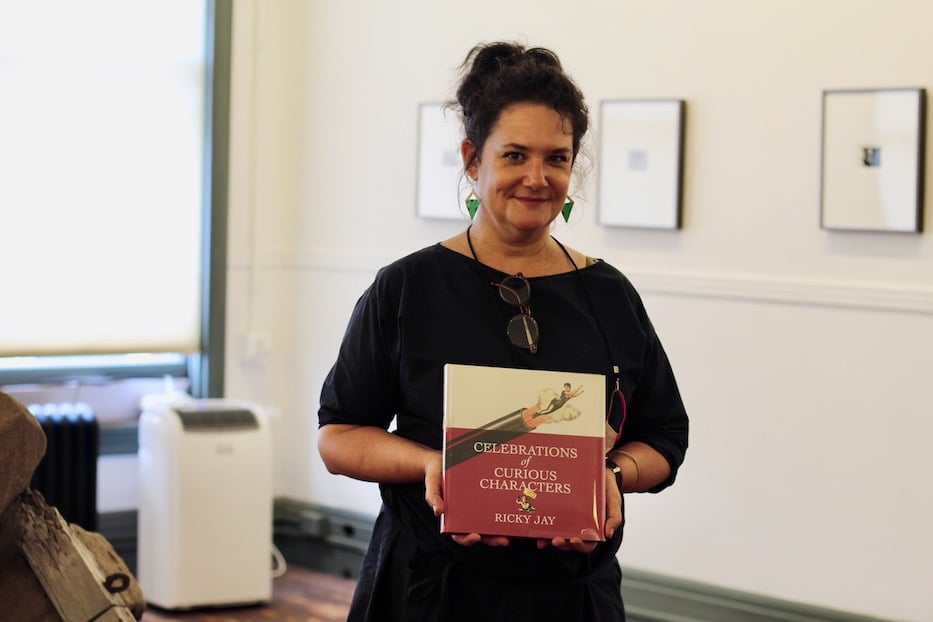
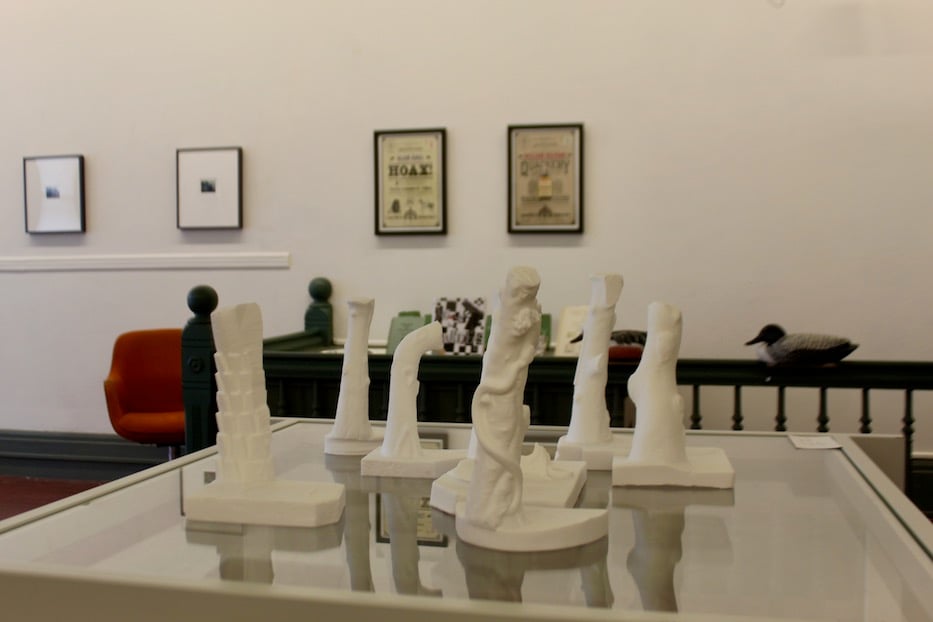
Top: Lewis. Bottom: Detail of Jeff Slomba's 2018 Arcadia.
“I was thinking a lot about what’s fake and what’s real, what lying is,” Lewis said on a recent Friday, as a mobile air conditioning unit fought the summer heat that seeped into the building. “It’s definitely a show where you have to look, and look twice.”
From the moment a visitor steps off the stairs, they can very much see those wheels turning. Beyond Schuldt’s carved wooden beer cans, book jackets peek out from every corner of the room, asking a viewer to come closer and inspect them. Along a back wall, Lewis has installed the wacky, whimsical “Book Jackets That Never Were,” creations of the late artist Edward Gorey that have a morbid sort of playfulness to them. She said that she is particularly grateful to former IL Director Will Baker, who made showing the works possible through an arrangement with the Edward Gorey Trust.
The decoy-ish nature of the work fits. There is, for instance, The Yellow Thing-ummy, a sort of rabbit-meets-alien in a cadmium yellow dressing gown, antennae sprouting from its head. Or The Other Book, in which a bespectacled man in a thick, voluminous and layered wool coat looks out over the abyss. The longer one looks, the more he seems like a comical sendup of art history’s taught-to-death Rückenfigur: his posture is uncertain, his head is too small for his body, the ground beneath him barely accommodates his feet.
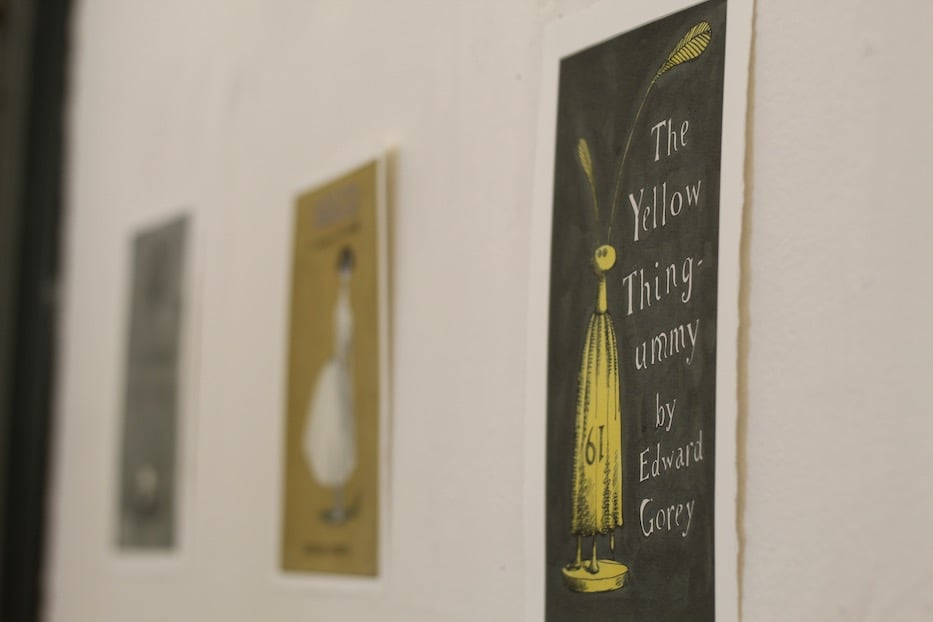
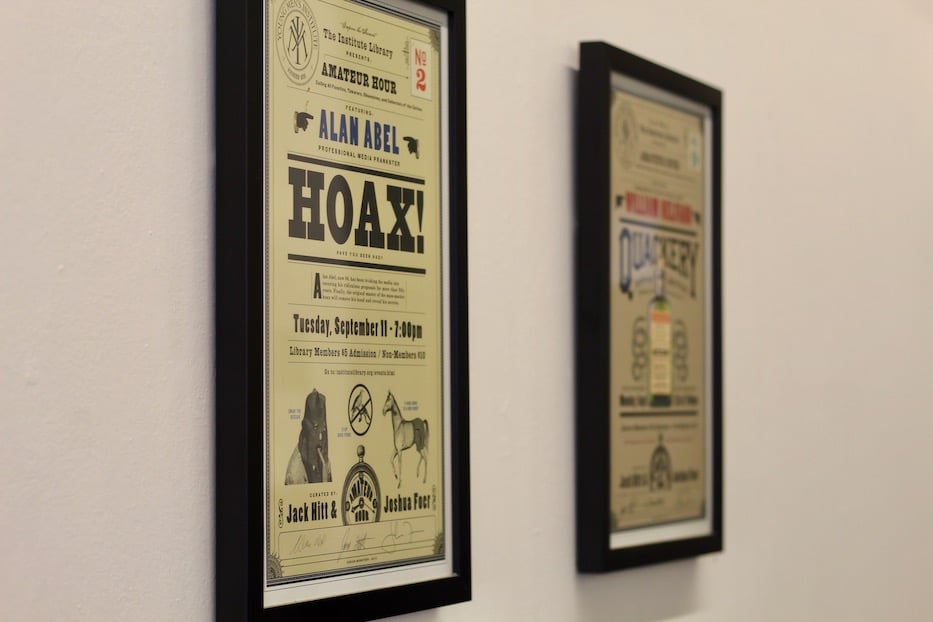 Top: Original cover art for "Books That Never Were." Courtesy of the Edward Gorey Charitable Trust. Bottom: Posters from the IL's "Amateur Hour" series.
Top: Original cover art for "Books That Never Were." Courtesy of the Edward Gorey Charitable Trust. Bottom: Posters from the IL's "Amateur Hour" series.
All of these books never came to be, leaving a viewer to imagine what strange and wondrous worlds might exist between their covers. And yet, there is nothing fruitless about them—it’s easy to see how Gorey’s very real influence lives on in the well-loved, contemporary works of Lemony Snicket (a.k.a. Daniel Handler), Tim Burton, and Wes Anderson among dozens of others. Beneath the illustrations, a copy of Alice Randall’s 2001 “The Wind Done Gone” beckons, as if a reframing of the antebellum South has always belonged in Gorey’s close company.
They feel right at home among a bogus field guide to decoy birds (also a Schuldt creation that has delicious layers of fakery), a seafoam-colored cover to the fabricated “Collected Malapropisms,” and a vitrine that holds published non-truths, satires, and fantasies. Beneath the glass, an essay from P.L. Travers describes exactly why she chose to use her initials, laying bare her Russian Doll of hopes for Mary Poppins, and her own sort of fake out in the process. Nearby, Harper's April 1989 issue announces “HE’S BACK!!!,” lampooning a growing media blitz culture with a spoof on Christ’s Second Coming.
In the spring of that year, the magazine was still helmed by now New Havener Jack Hitt, who later ran the IL’s much-beloved “Amateur Hour” series with Joshua Foer. It’s hard not to laugh at how well-executed the sendup is—particularly if one finds the second coming itself kind of funny.
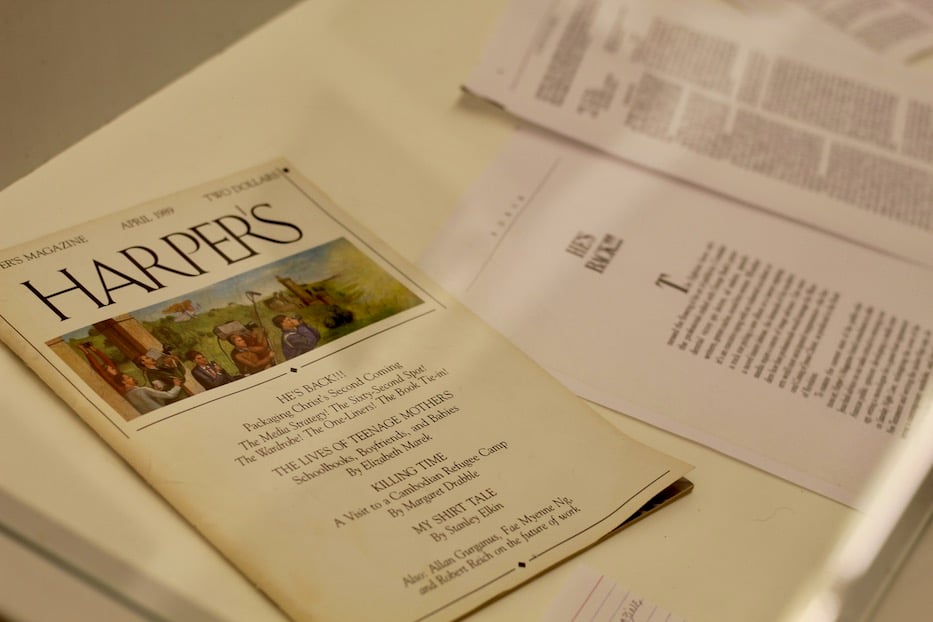
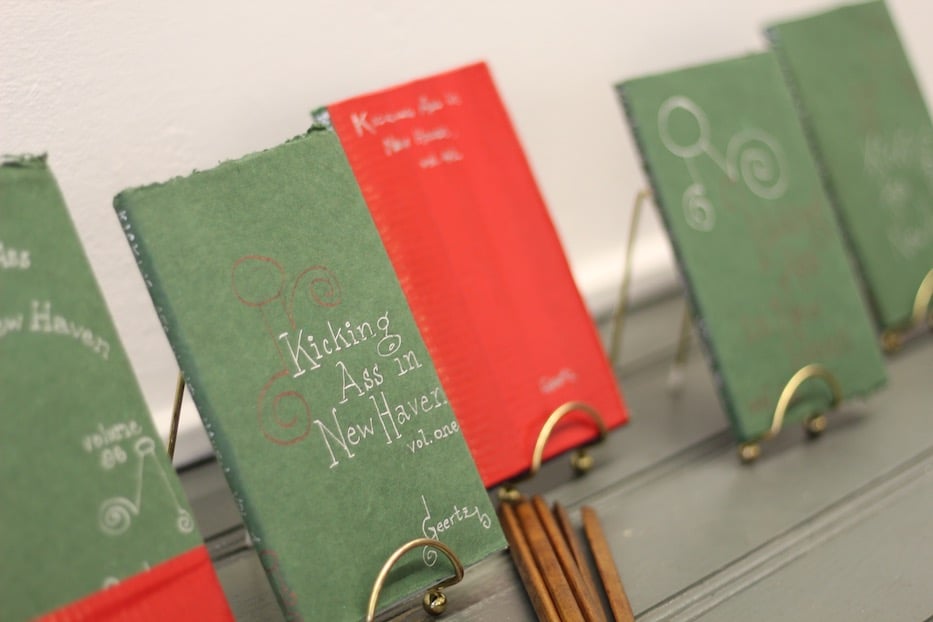
Top: The April 1989 issue on the media strategy around Christ's second coming. Bottom: Eva Geertz's Kicking Ass In New Haven.
Some submissions are wonderfully, wackily inventive, getting at the half-truth that lives between conscious and subconscious, the world as it should be and the world as it is. Just feet from Schuldt’s duck decoys—painted with the plumage of other birds—there are copies of the never-before-seen zine Kicking Ass In New Haven, fabricated courtesy of IL Operations Manager Eva Geertz.
Along the faux-weathered cover, embroidered white lettering spells out the title of the publication, with a kind of spiralling yoyo-meets-scale that becomes the magazine’s logo. Viewers who know Geertz—and even those who don’t—can only imagine what magic and hilarity might be waiting inside, as she chronicles the city through her witty lens. But it’s a fakeout: Geertz pulled the title from a dream her husband, Ben Geertz, had years ago. The exhibition gave her a chance to make the title, itself a product of his subconscious, into a not-quite-reality.
All of these get at the question of the reliable narrator, hitting notes that are at turns funny, biting and macabre. After all, what’s more timely than a book of untruths in a year that has included the fall of Roe, January 6 hearings, a climate bill that rewards fossil fuel corporations, and racism so insidious that a city of 150,000 primarily Black residents has been without clean water for months? What’s more of a farce than the idea of America itself?
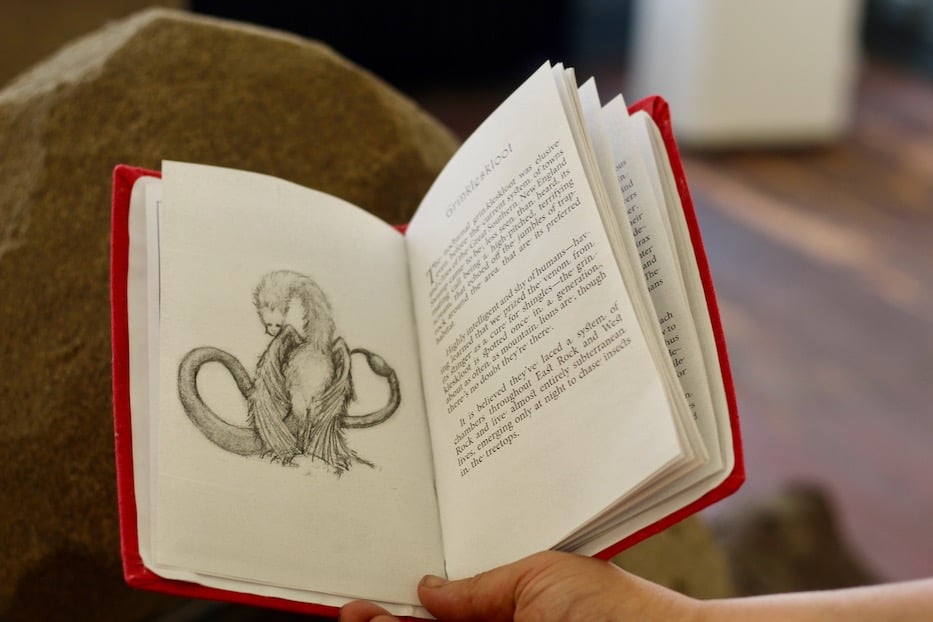
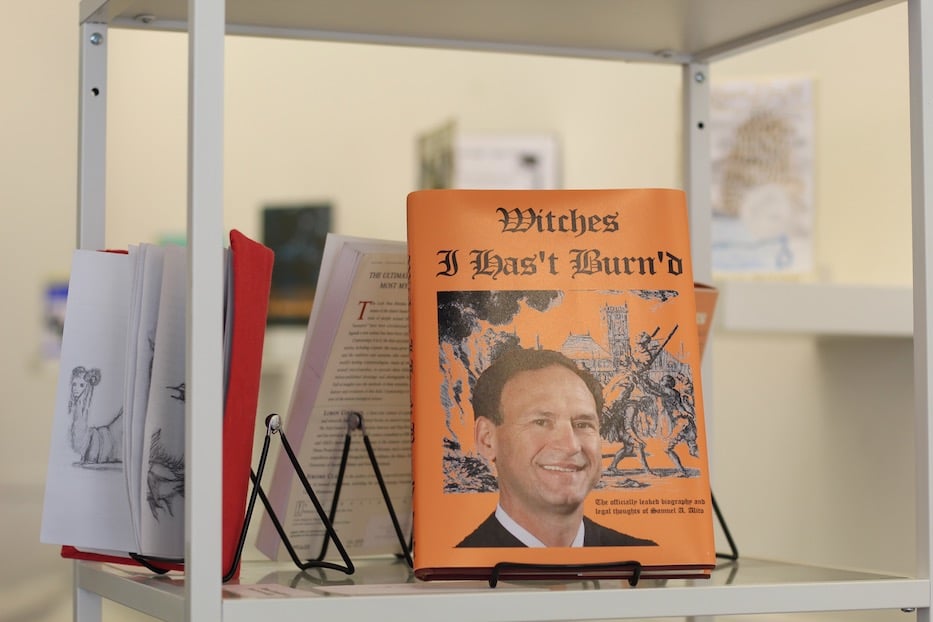
Top: Detail, “Beasts of the Great Southern New England Swamp,” a book from artist Zohra Rawling and writer Brian Slattery. Bottom: A fictitious biography of Samuel Alito, the U.S. Supreme Court Justice who penned the opinion in Dobbs v. Jackson Women's Health Organization earlier this year.
Here, Lewis also has a gift for bringing together the work of living Connecticut artists and the library’s collection, a hodgepodge of titles that reaches from 1826 to today (or in her words, yoking “snake oil salesmen and the internet”). Across the room from fake book jackets—and some real ones—hang George Corsillo’s prints from the IL’s much beloved “Amateur Hour,” as if they have sized up the other half-truths in the room and are ready to have a conversation.
There are plenty of places for that dialogue to start. Shelves around the room boast titles including The Onion’s too-apt “Our Dumb World,” a laughable, Cheeto-orange “Witches I Has’t Burned,” with a gothic backdrop and smug-faced Samuel Alito, a satirical Guns & Gardens magazine from artist Rita Valley (not to be confused with the very real Southern publication of a similar name). Just when things feel unbearably heavy, there is the completely magical and unexpected “Beasts of the Great Southern New England Swamp,” a welcome reprieve from artist Zohra Rawling and writer Brian Slattery.
Nearby, artist Marsha Borden has piled nipple-less breast pads, such that the soft, rounded discs look like they’ve been torn from a bra and discarded on the side of some strange road. On the floor, artist Leila Daw has assembled a pile of large bricks from a fabricated civilization. Stacked atop each other, they appear as rubble, making a viewer both ask what they once were and wonder what culture might fall next. It’s not just the objects that work, but the way they take up space, creating an alternate narrative through the very fact of their existence.
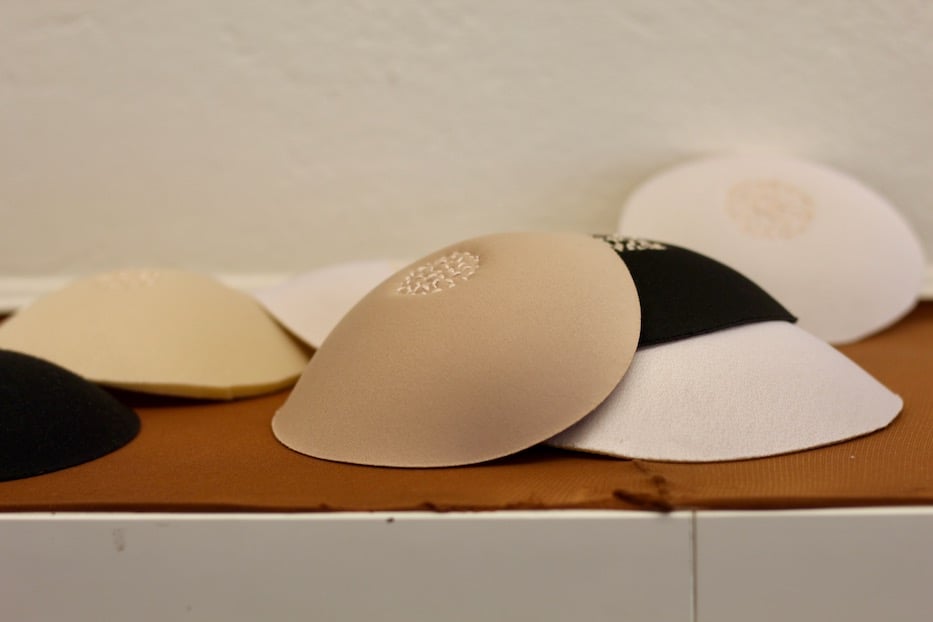
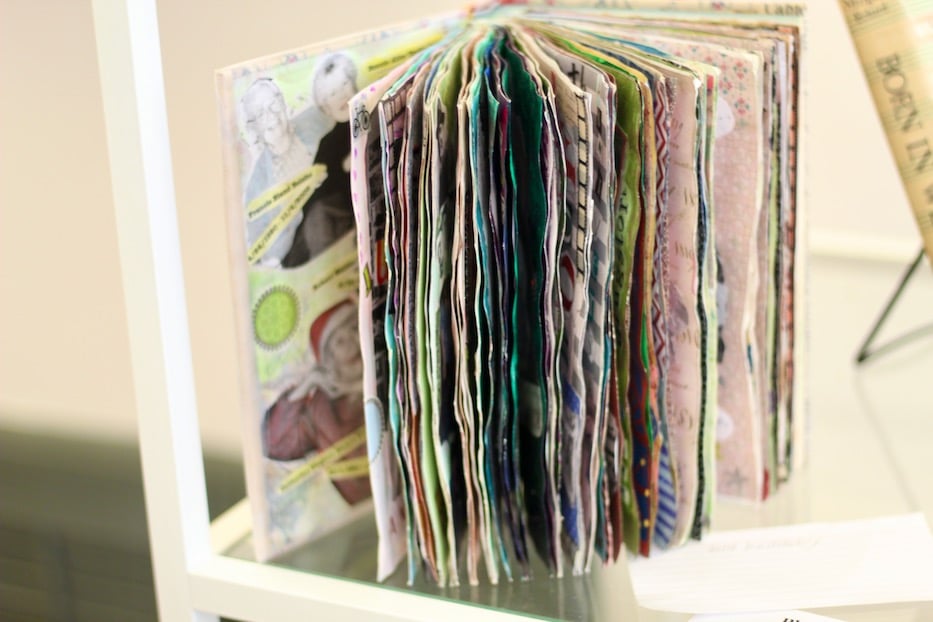
Top: Marsha Borden's installation. Bottom: Ann Kennedy's colorfully collaged chronicle of her family.
So too two works from sculptor Jeff Slomba, whose own interest in 3D printing pushes a viewer to think about where the physical act of making begins and ends. In his 2018 Arcadia, Slomba has 3D-printed columns without figures leaning on their supports, making them into entirely different objects for a viewer to explore from every angle. It resonates in his Doric Collapse, a video of 3D-printed doric columns righting themselves into a Greco-Roman facade, and then collapsing inward.
If the message that Democracy is in great peril has not already come across in the exhibition—complete with a guffaw or ten—the video makes it clear. And yet, Slomba’s structure also looks like a toy, as if someone is futzing with their legos or Lincoln Logs. There’s a palpable tension between the urgency of the piece and the lightness of children’s play.
In many ways, that’s the spirit of the show itself: that the world is more precarious because of these falsehoods just beneath the surface, but sometimes more interesting too. Lewis serves it up with a laugh—worth a first look, and a second, and a third. Catch it before it’s gone.
Decoys & Mimics runs in the gallery at The Institute Library, located at 847 Chapel St. in downtown New Haven, through Sept. 22. The Institute Library is open Tuesday through Friday from 11 a.m. to 5 p.m. and Saturday from 12 to 2 p.m. A closing reception is scheduled for Sept. 21 from 5 to 8 p.m.

